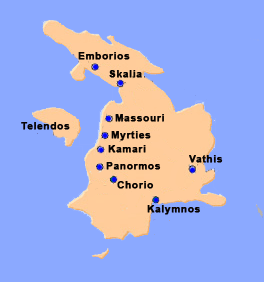|
Kalymnos Island |
|
|
|
Kalymnos covers an area of 110 km2 and has a coastline of 96 km. It is a mountainous island, with two green valleys on its southern side, where the majority of its settlements are located. Among them is the capital, Kalymnos or Pothia, which is a relatively recent settlement, built within the past century, when the inhabitants abandoned their village in the mountains and built a new one on the sea. The architecture of the capital, a relatively new settlement, has few characteristic elements, but its intensely colored white and blue houses, with red tool roofs, impress visitors. The village of Chorio, the old capital, is an example of the local architecture. Also, small white churches are scattered throughout the island. The northern part of the island is mountainous and uninhabited. Kalymnos was always known for the sponges that its inhabitants collected from ancient times in its waters and farther out in the Aegean Sea. Sponges continue to be collected since now. Kalymnos have beautiful beaches, some pebbled and some sandy. On the island, there are therapeutic springs, near the capital. In Ancient times, the Dorians colonized the island, the history of which had no important events and is tied with that of nearby Kos. In Classical times, it was an ally of Athens and later it passed under the domination of Rome. Later in its history, the island was conquered by the Venetians in 1204, the Turks in 1522 and the Italians in 1912. It became part of Greece in 1948. The most important product of the fertile valleys of the island are citrus fruits, which also are exported. Half a mile from Kalymnos, there is the small barren island of Telendos, a quiet characteristic place of fishermen and of sponge divers. Kalymnos offers quiet and beautiful vacations, in an intact environment of natural beauties.
Place of interest Damos ruins of an Ancient City, 3 km from the capital. Medieval Castle, near the capital, with the church of Panagia Crisohera, within its walls. Castle of the Knights of Rhodes, near the village Chorio. Caves The Nymphon’s cave and Kefalas’ cave, in the south, and the cave of Dascaleio in the north with a reach decoration of stalactites are very interesting. Transportation By Air There is no airport. Nearest airport is in Kos. From Athens to Kos there are flights every day (50 minutes) By boat From Piraeus, by ferry (183 n.m.) in about 11 hours Also by hydrofoils from Kos, Leros and Patmos
|
